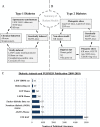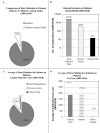Future Perspective of Diabetic Animal Models
- PMID: 31241444
- PMCID: PMC7360914
- DOI: 10.2174/1871530319666190626143832
Future Perspective of Diabetic Animal Models
Abstract
Objective: The need of today's research is to develop successful and reliable diabetic animal models for understanding the disease susceptibility and pathogenesis. Enormous success of animal models had already been acclaimed for identifying key genetic and environmental factors like Idd loci and effects of microorganisms including the gut microbiota. Furthermore, animal models had also helped in identifying many therapeutic targets and strategies for immune-intervention. In spite of a quite success, we have acknowledged that many of the discovered immunotherapies are working on animals and did not have a significant impact on human. Number of animal models were developed in the past to accelerate drug discovery pipeline. However, due to poor initial screening and assessment on inequivalent animal models, the percentage of drug candidates who succeeded during clinical trials was very low. Therefore, it is essential to bridge this gap between pre-clinical research and clinical trial by validating the existing animal models for consistency.
Results and conclusion: In this review, we have discussed and evaluated the significance of animal models on behalf of published data on PUBMED. Amongst the most popular diabetic animal models, we have selected six animal models (e.g. BioBreeding rat, "LEW IDDM rat", "Nonobese Diabetic (NOD) mouse", "STZ RAT", "LEPR Mouse" and "Zucker Diabetic Fatty (ZDF) rat" and ranked them as per their published literature on PUBMED. Moreover, the vision and brief imagination for developing an advanced and robust diabetic model of 21st century was discussed with the theme of one miceone human concept including organs-on-chips.
Keywords: Animal model; diabetes mellitus; humanized animal model; immunotherapies; meta-analysis; pathogens..
Copyright© Bentham Science Publishers; For any queries, please email at epub@benthamscience.net.
Figures


Similar articles
-
Alterations in pancreatic protein expression in STZ-induced diabetic rats and genetically diabetic mice in response to treatment with hypoglycemic dipeptide Cyclo (His-Pro).Cell Physiol Biochem. 2012;29(3-4):603-16. doi: 10.1159/000338514. Cell Physiol Biochem. 2012. PMID: 22616141
-
Reduction of oxidative stress by a new low-molecular-weight antioxidant improves metabolic alterations in a nonobese mouse diabetes model.Pancreas. 2007 Nov;35(4):e10-7. doi: 10.1097/mpa.0b013e318150e4f2. Pancreas. 2007. PMID: 18090226
-
Electrophysiological characterization of spinal neurons in different models of diabetes type 1- and type 2-induced neuropathy in rats.Neuroscience. 2015 Apr 16;291:146-54. doi: 10.1016/j.neuroscience.2015.02.003. Epub 2015 Feb 14. Neuroscience. 2015. PMID: 25686525
-
Development and application of rodent models for type 2 diabetes.Diabetes Obes Metab. 2005 Jul;7(4):307-17. doi: 10.1111/j.1463-1326.2004.00392.x. Diabetes Obes Metab. 2005. PMID: 15955116 Review.
-
Experimental Diabetes Mellitus in Different Animal Models.J Diabetes Res. 2016;2016:9051426. doi: 10.1155/2016/9051426. Epub 2016 Aug 9. J Diabetes Res. 2016. PMID: 27595114 Free PMC article. Review.
Cited by
-
A novel model mouse for type 2 diabetes mellitus with early onset and persistent hyperglycemia.Exp Anim. 2022 Nov 10;71(4):510-518. doi: 10.1538/expanim.22-0061. Epub 2022 Jul 28. Exp Anim. 2022. PMID: 35896366 Free PMC article.
-
Diabetic Neuropathic Pain and Serotonin: What Is New in the Last 15 Years?Biomedicines. 2023 Jul 6;11(7):1924. doi: 10.3390/biomedicines11071924. Biomedicines. 2023. PMID: 37509563 Free PMC article. Review.
-
Brown adipose tissue: a potential therapeutic target for preventing cardiovascular disease in metabolic disorders.Diabetol Metab Syndr. 2025 Aug 2;17(1):311. doi: 10.1186/s13098-025-01892-5. Diabetol Metab Syndr. 2025. PMID: 40753433 Free PMC article.
-
Neuroprotection from protein misfolding in cerebral hypoperfusion concurrent with metabolic syndrome. A translational perspective.Front Neurosci. 2023 Aug 15;17:1215041. doi: 10.3389/fnins.2023.1215041. eCollection 2023. Front Neurosci. 2023. PMID: 37650104 Free PMC article. Review.
-
Inflammation triggered by the NLRP3 inflammasome is a critical driver of diabetic bladder dysfunction.Front Physiol. 2022 Nov 25;13:920487. doi: 10.3389/fphys.2022.920487. eCollection 2022. Front Physiol. 2022. PMID: 36505062 Free PMC article. Review.
References
-
- Denayer T., Stöhr T., Van Roy M. Animal models in translational medicine: Validation and prediction. New Horiz. Transl. Med. 2014;2(1):5–11. [http://dx.doi.org/10.1016/j.nhtm.2014.08.001].
-
- Balls M. The wisdom of Russell and Burch. 3. Fidelity and discrimination. Altern. Lab. Anim. 2013;41(1):12–14. [http://dx.doi.org/10.1177/026119291304100120]. [PMID: 23614551]. - PubMed
-
- Andes D., Craig W.A. Animal model pharmacokinetics and pharmacodynamics: a critical review. Int. J. Antimicrob. Agents. 2002;19(4):261–268. [http://dx.doi.org/10.1016/S0924-8579(02)00022-5]. [PMID: 11978497]. - PubMed
-
- Zhao M., Lepak A.J., Andes D.R. Animal models in the pharmacokinetic/pharmacodynamic evaluation of antimicrobial agents. Bioorg. Med. Chem. 2016;24(24):6390–6400. [http://dx.doi.org/10.1016/j.bmc.2016.11.008]. [PMID: 27887963]. - PubMed
Publication types
MeSH terms
Substances
LinkOut - more resources
Full Text Sources
Medical
Miscellaneous

